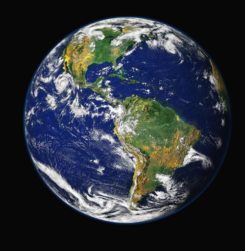MUSANZE – THEY GRABBED blankets, clothes and mattresses and rushed out of their houses at dawn. In their tens of thousands, they streamed out the city of Goma, in eastern Congo, terrified of what its volcano might do next. Some fled east towards the nearby border with Rwanda. Others hurried west to the Congolese town of Sake, around 20km away, clogging the dirt road from Goma with motorbikes, cars, trucks and pedestrians. Hundreds of people rushed down to Goma’s port to pile onto boats heading to Bukavu, a city across the lake.
The exodus began in the early hours of May 27th, when the governor of North Kivu, the province that includes Goma, ordered the immediate evacuation of about 600,000 residents in the centre of the city; perhaps another 1.5m live in other parts of Goma and many of them did not wait to be ordered to leave. The governor, Lieutenant-General Constant Ndima, announced that Mount Nyiragongo might erupt again at any moment. It was only five days since lava had burst out of Mount Nyiragongo and streamed towards this ramshackle city.
Now, said General Ndima, magma had been detected underneath the city centre, and underneath the vast, deep Lake Kivu, by which Goma sits. “An eruption on land or under the lake cannot be ruled out, and it could happen very quickly and without warning,” he announced. His broadcast sparked chaos.
It was the second mass flight in a week, and bigger than the first. On May 23rd Goma’s residents ran away from the approaching lava, which flattened districts in the northern outskirts but stopped short of the centre (and just spared the airport). Some 32 people were killed and around 1,000 houses were destroyed, according to the United Nations. Lots of families were separated in the chaos. Days later, weary children hung around shelters run by NGOs, hoping their parents might come and find them.
Goma has experienced more than 300 earthquakes since the eruption on Saturday. One was big enough to knock down a two-storey building. A deep crack has opened up in the road next to Goma’s main hospital. Residents fear that, if there is another blast, lava could spurt out of this crack, engulfing the city centre. An even deadlier risk is the prospect of a limnic eruption, triggered by earthquakes and volcanic activity. Dissolved carbon dioxide would explode from the lake’s deep waters, possibly sending a tsunami-like wave over Goma. Worse, it could form a deadly cloud of gas. The vast volume of carbon dioxide could asphyxiate everyone in Goma and Gisenyi, a lakeside town just over the Rwandan border.
Limnic eruptions are rare but deadly. The last one, in Cameroon in 1986, killed more than 1,700 people, some as far away as 25km from the lake. If the lava believed to be bubbling beneath Lake Kivu raised its temperature by more than one degree Celsius, there could be an “overturn”, or limnic eruption.
“When you see something bizarre, something strange, a discolouration of the lake, increasing temperature of the lake or bubbling inside the lake, please report it,” urged Dario Tedesco, a volcanologist monitoring Nyiragongo, in a press conference on Wednesday. These signs, accompanied by a smell of rotten eggs given off by sulphur dioxide, could mean that the lake is about to flip. Last night, your correspondent dipped her fingers in the choppy water and had a good sniff of the air, before going to bed for a few hours. By 6am, she, along with thousands of others, was heading for the Rwandan border on a motorbike, to take refuge up in the hills.
Saturday’s eruption took the residents of Goma by surprise. This might, in part, have had something to do with the fact that the city’s volcano observatory has barely received any money since October 2020, when the World Bank’s funding cycle ended. The bank decided not to cough up again when it emerged that many of the employees on the observatory’s payroll were not actually working there. Since the funding stopped, most of the staff who really do monitor the volcano have also not been paid; some have stopped turning up.
Lots of Goma’s residents are staying put and hoping for the best. Many fear that if they leave, their homes will be looted. “I have everything here, I cannot leave,” says one man, Eddygar Shombo. “Yes, if the lake explodes, I will die, but I don’t think it will.” He lived through the eruption in 2002 and hopes that this one will follow a similar pattern. Eventually, he hopes, the earthquakes will stop and the lake’s rough waters will calm down.
By The Economist






